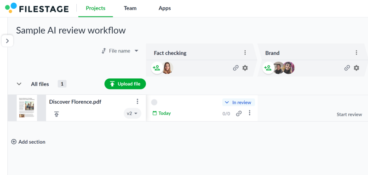The trend of in-house marketing and advertising has grown some profound steam worthy of recognition and interest for more than 10 years now. According to statistics from Adweek, companies of all sizes have reduced expenses in creative content production by more than 30% simply by shifting responsibility from external agency partners to in-house marketing and creative teams.
According to one survey, 80% of respondents concluded that the rise of in-house marketing and content production is accompanied by high levels of satisfaction.
What Is In-housing? And In-house Marketing?
Moving forward, it is crucial to understand both terms.
In-housing
In-housing, just as it sounds, means “in the house”. According to Investopedia, “In-house refers to conducting an activity or operation within a company, instead of relying on external resources (outsourcing).”
What in-housing means in the real sense, is a company performing its operations and activities by using its internal employees, resources and assets. It is the direct opposite of outsourcing.
A company may decide to keep all or some activities in-house. The process of doing this is sometimes called “insourcing”. Activities may include content creation, payroll, technical support, task management, and more. While it is very common to outsource these operations, a business can attain flexibility and more control if they choose to keep them in-house.
In-house marketing
In-house marketing, on the other hand, is simply any marketing activity that is not outsourced to a third party. All of a company’s marketing processes, including advertising, content production, etc. would be completed by its own staff, without the assistance of an external agency.
Some companies may choose to employ an expert to assist an in-house marketing team in effectively implementing its marketing initiatives.
5 Factors Pushing Companies to Produce More Content In-house
With marketing trends shifting to in-house production, the factors prompting this relocation from outsourcing are worthy of note. The following are possible factors pushing companies to produce more content in-house as opposed to hiring an external agency.
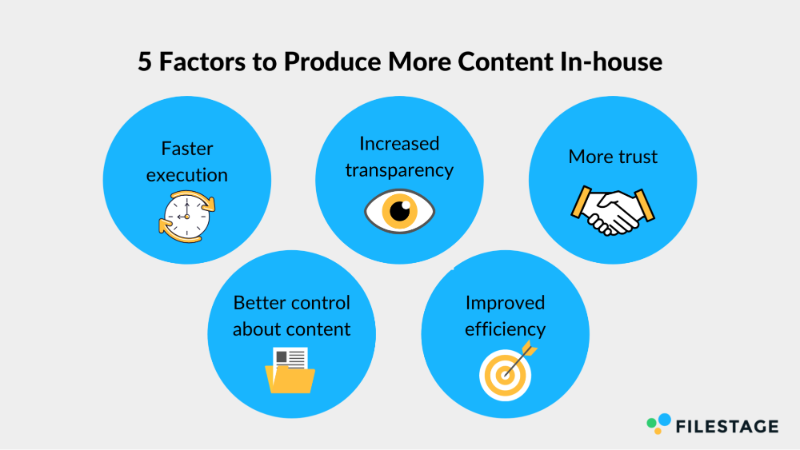
Faster execution
A company employing an outside agency may find that tasks are executed more slowly. This can be worse for small businesses or individual entrepreneurs as delays in their projects and plans can cause a big shift in momentum. Slower execution rates can happen for several different reasons. As presented in the Journal of Marketing Management, ineffective communication between a company and agency is a major reason for slow execution and poor productivity in a client-agency collaboration.
In-housing, on the other hand, can increase the rate of execution of projects, ideas, strategies, and plans. Team members are readily available, and it’s easier to shift priorities in response to the changing market. This bridges the communication gap and the need to always stay in touch when executing a project.
Increased transparency
When employing or outsourcing to an agency, a company may lose transparency regarding the steps or procedures taken to deliver results as well as the progress of certain projects. Your business needs transparency to ensure that every project is progressing as planned and to stay ahead of its short and long-term goals.
Transparency is simplified when projects are completed in-house as progress is very obvious and even signed off by management.
More trust
Content production sometimes requires companies to disclose very sensitive information. Outsourcing can put your company’s confidentiality at risk.
Additionally, some content production processes require the disclosure of consumer information. Although the use of consumer information is often done by obtaining consent, unconsented third-party access through outsourcing or data leaks can threaten your brand’s integrity.
Creating your content in-house solves most of the confidentiality problems that may arise in your work. All client data remains in-house, and replicable ideas are less likely to slip into the wrong hands.
Better control about content
Having control of content production (how it is created, its frequency, etc) is one of the perks that comes with in-housing and in-house marketing.
Moreover, performing marketing and content production in-house allows a company to maintain better control of the quality and tone of their messaging to consumers. It also helps a company review and fulfill compliance and legal requirements.
Outsourcing, on the other hand, may provide some level of flexibility, but it can be at the expense of quality control and runs the risk of inconsistency in brand voice.
Companies are pushing toward in-housing to avoid these challenges and build more reputable brand images as they gain full control over content production, consistency, and quality.
Improved efficiency
As stated earlier, communication glitches or misunderstandings can make working with agencies frustrating. Your company may have to repeatedly resolve bottlenecks in order to produce the desired results.
Not every manager has the patience to handle an external process while focusing on getting internal affairs in their organization together. Therefore, building an in-house marketing team has become a better option for business leaders. This way, they can communicate without friction and accomplish more with minimal challenges.
What Are the Benefits of Having an In-house Marketing Team?
Marketing requires a constant push to be successful. If your company needs long-term, full-time marketing attention, you should consider building an in-house marketing team. Not only will a dedicated marketing team focus all its energy and time on your brand, it will also unlock huge benefits that include the following:
Faster workflow
Agencies and external contractors operate to serve businesses like yours. They are likely not serving your business alone. This can affect how fast work is completed as they have to maintain their loyalty to all their clients. Clients have varying goals and delivery frequencies. So, agencies are often at a crossroads, facing multiple, competing client demands.
However, by building an in-house marketing team, you can quicken workflow significantly since every member of the team is solely focused on helping your business grow. Your internal marketing team will be responsible for only one set of goals: yours. This makes task completion and workflow faster since all hands are on deck.
Easier communication and collaboration
The value of communication cannot be overemphasized. It’s even more effective if it happens swiftly with no bottlenecks. Collaboration is also an important part of teamwork.
With an in-house marketing team, communication and collaboration are faster and simpler than when dealing with outside agencies. There are a few reasons for this, including:
- The whole team uses the same marketing workflow software to collaborate and communicate.
- The goals and expectations for each project are clear and worked on together.
- There is less explanation required to communicate expectations and goals since everyone is a part of the same company and already possesses background knowledge of the products or services.
Better access and security of data
As mentioned earlier, building an in-house marketing team helps keep your data secure within the organization. You do not have to share client or company data with third party agencies for any reason. This adds an effective layer to your company’s data security.
Access to data is also improved when working with an in-house marketing team. Depending on your choice of content management tool, you can allow all official company email users to access a set of data. This way, you don’t have to grant individual access to your team members.
With access to all data in-house, your marketing team can have better data insight to drive decisions and facilitate the creation of more suitable content, thus increasing customer conversion.
Better ownership over brand communication
As stated previously, agencies typically work with several clients at the same time. As such, they try to communicate brand messages in various ways that may affect coherence.
If you want to have stronger control over how consumers perceive your brand, you need to own the communications. And, as you already know, good marketing is effective communication.
By building an in-house marketing and design team, you maintain full control over how your brand is communicated and presented to your target audience. You can choose the look and feel of your design, as well as the tone of voice, frequency of communication, and so much more.
Deeper knowledge of the brand and product
With an in-house marketing and design team, your employees develop a deeper understanding of your brand, products, customers and target audience. Effective marketing requires good research and comprehension skills. Therefore, ensuring that this knowledge remains within your organization can help you improve your product offerings as well as your brand image.
What Are the Challenges and Disadvantages of In-house Marketing?
While in-housing is being widely adopted by companies, it does come with challenges. This section discusses some potential challenges or disadvantages of in-house marketing.
Limited capacity of human resources
If you are a small company with a small marketing team, there’s a limit to what you can accomplish because of the limited skill sets at your disposal. For this reason, in-housing can be quite challenging.
Big businesses, on the other hand, may have the human resource capacity to handle huge marketing activities. However, some large companies, after reviewing various agency prices, may prefer to cut costs by hiring a marketing agency to handle their marketing activities.
Should they decide to stick with an in-house marketing team, managing a large team can become a challenge of its own. With a huge internal marketing team, company leaders have to break silos for easy management. This could slow down communication significantly.
Some larger companies prefer a hybrid approach to marketing. They may have an agency handle some of the marketing activities while they build a small, in-house design or marketing team to complement the agency’s efforts. The decision as to which approach to take rests entirely on the company’s management and business strategy.
Ideas are uncontested and suggestions are limited.
Sometimes, marketing in-house keeps the whole idea within the organization. Since your marketing plans and strategies are not shared with any third party, the efficacy of the idea is limited to the perspectives available within your internal team.
Bringing an agency on board can present your business the opportunity for your plans and strategies to be scrutinized. A good agency shares its perspectives and reservations about your company’s marketing plans and processes. Therefore, outside observations could be a significant advantage, especially if you are trying to market to an unfamiliar or new audience.
Missing support from an external expert
Some digital marketing agencies bring years of marketing experience to the table. As such, they have the skills required to help your business penetrate a new market.
Running an in-house marketing team, on the other hand, limits the expertise to what your employees already know. Even though you may have the best talent, you may benefit from external experts who can contribute their unique support to optimize your marketing and advertising campaigns.
Marketing agencies are well equipped with experts. Most agencies are founded and operated by experts who possess decades of marketing and advertising experience. So, if you choose an in-house marketing team over agencies, the opportunity of working with external experts may elude you.
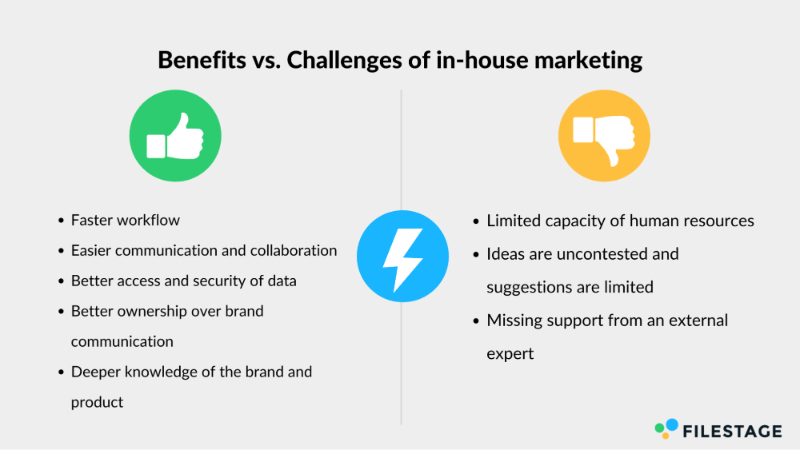
What Are the Benefits of Working with a Marketing Agency?
Although marketing trends are shifting activities to in-house teams at a very fast pace, it is still important to review these possible benefits of working with marketing agencies.
Bring in fresh ideas
Your marketing plans may be well conceived and considered flawless. But, this could be because they have only been reviewed by your internal team. In some cases, you may be oblivious to the gaps in your strategy or plan. However, working with a marketing agency, especially those where the experts have substantial experience in the marketing sphere and your particular industry, can enable further scrutiny of marketing plans and a fruitful exchange of ideas.
Deep knowledge of industry best practices
As we emphasized earlier, the knowledge and experience of experts with decades of industry experience might be difficult to match with an in-house team. So, smart businesses try to make the most of their expertise in the industry. They do this by hiring agencies with proven records of success.
Bigger skill sets
A fortified marketing team needs a broad range of skills in its arsenal, including SEO, content creation and editing, backlinking, social media management, advertising campaign management, and so much more. There’s a limit to what an in-house marketing team can accomplish with the skills at their disposal.
Agencies, on the other hand, have experts in the various areas of marketing required to bring your goals to fruition. This is an opportunity that most businesses choose to exploit.
Improved flexibility
Much planning goes into content production and digital marketing. You can save yourself all that stress by hiring an agency to do what they know best. Also, agencies often provide short-term and/or on-demand support for very specific topics. This support grants your team the opportunity to improve flexibility and focus on other more productive tasks that are within your areas of expertise.
Higher creativity
No doubt, agencies have access to creative tools. Top agencies have worked with some of the finest talents in the industry. They know who is best suited for any particular type of task unlike an in-house marketing or design team facing a limited talent pool.
Furthermore, being an agency, creatives (designers and writers) are allowed the flexibility to perform their magic partly because they understand themselves. As we know, freedom fuels creativity and agencies offer a lot of it. You can make the most out of this creativity if you hire an agency instead of building an in-house marketing team.
What Are the Disadvantages of Working with a Marketing Agency?
Despite the advantages of working with a marketing agency, there are several drawbacks to keep in mind when considering following the agency path.
Communication is slow.
Remember that the value of communication cannot be overemphasized in any business. Again, communication is far more effective when prompt because more can be done in a shorter amount of time. However, you can only enjoy the luxury of prompt communication if your marketing team is in-house.
Agencies serve several clients at any given time and try to prioritize every client’s needs. So, in times of high volume requests, agency communication may not be as fast as the communication speed obtainable with in-house marketing teams.
Also, because agency clients (businesses mostly) use various communication tools, many agencies prefer to keep communication via email or phone. Although phone calls can be faster, constantly taking calls could be inconvenient for companies. So, the slower email option is mostly used.
Detailed briefings are needed.
To help agencies manage client expectations, they require clear communication of goals. Therefore, you are responsible for providing a detailed brief of all your digital marketing needs every time you have a marketing request.
Collaboration can be difficult and slow.
In many cases, there are no pre-established processes between the brand and the agency for the completion of tasks and projects. With activities happening almost haphazardly, collaboration speed can be significantly reduced. This affects the bottom line in several ways; for example, difficult and slow collaboration may cause a brand to enter the market later than the competition.
Decision making is less data-driven.
As mentioned earlier, there’s a limit to the access you can grant an agency when it comes to consumer and company data. This restriction from data access can result in agencies making decisions with limited data to guide them. Blind decisions can significantly affect the efficiency of your marketing or advertising campaigns, resulting in lower conversion rates.
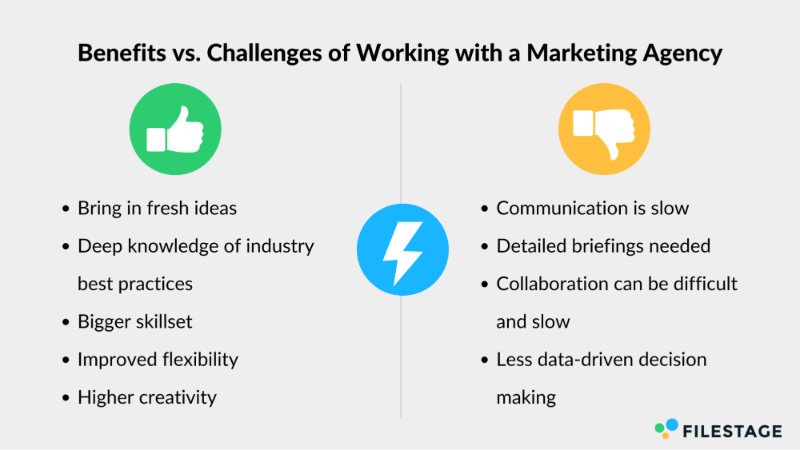
Other Opportunities: Considering the Hybrid Approach
Reaching a decision of whether to go in-house or outsource can put business owners at a crossroads. For businesses with a decent marketing budget and limited internal, a hybrid approach might be a good route to follow.
What is the hybrid approach to marketing?
As the name implies, a hybrid approach to marketing is the use of both in-housing and outsourcing to pursue your marketing goals. It’s not as complicated as it sounds, yet it’s not entirely simple either. If done haphazardly, a hybrid approach could be a disaster.
An understanding of how hybrid marketing works can help you determine whether or not it is suitable for your business.
How does the hybrid approach work?
You can build an in-house marketing team that can handle swift response marketing activities and also employs an agency to take care of tasks that require greater expertise. In this way, the teams complement each other.
Additionally, your in-house team can work synchronously with an agency on the same project. Instead of acting as separate teams, your in-house team and agency become two parts of one big marketing team.
To implement this hybrid approach effectively, you must set clear roles and expectations for each team. This way, both your in-house team and the marketing agency are fully aware of their responsibilities and what’s expected.
The benefits of a hybrid approach
Combining in-house marketing and outsourcing can triple the impact of each model working on its own. The deep connection between an agency and a company’s in-house marketing team, when nurtured properly, can make a firm into a marketing giant. Some of the actual benefits derived from this combination include:
- Achieve data-driven decision making without granting third parties access to company and consumer data.
- Access industry experts without having to convince one to join your company as an employee.
- Leverage the power of the best agency marketing softwares that may not otherwise be at your disposal.
- Brainstorm more effectively with more efficient marketing plans and strategies. This is achieved because both in-house and external perspectives are considered.
3 Tips That Can Make Your In-house Marketing More Efficient
Have you decided to go with the in-house option? Consult these tips to help you make the best out of your rockstar marketing team.
Use the right tools.
Good communication software is built to make team communication fun and easy. Most of the top communication tools for in-house marketers have mobile apps and push notification features. These features help you receive important work-related messages in real-time and respond to them accordingly.
Even though communication and collaboration occur simultaneously, there are also tools designed specifically to facilitate team collaboration. The best ones help you improve your team’s productivity while allowing secure file storage and multi-level permissions.
Some of the tools that we can recommend for better team collaboration and communication are:
- Asana: Its direct messaging and easy file sharing, commenting and mentioning features make it easy for large and small marketing teams to collaborate and communicate, both in-house and with agencies.
- ClickUp: This is another good communication and team collaboration tool that can help you keep all your digital marketing affairs in one place, stored with end-to-end encryption.
- Trello: This is a popular project management tool that allows both big and small teams to collaborate on tasks with minimal friction.
Employ good collaboration techniques.
A report from McKinsey shows that employees spend 28% of their workweek digging up information and tracking down the details of tasks. It also reveals that you can achieve 66% more improvements in your company’s productivity through effective communication and collaboration.
You can build an effective team for marketing in-house through collaboration and open communication. These seven collaboration techniques can help you achieve this purpose:
- Use engaging collaborative games to instill team spirit.
- Encourage honest and open communication between team members.
- Use collaboration software.
- Reward collaborative efforts.
- Encourage creativity and innovation among team members.
- Set and communicate clear goals and expectations.
- Get involved and lead by example.
Give and receive feedback to improve your work.
Giving feedback to your in-house team is crucial for many reasons. Firstly, it can help correct errors in the content before they are published. Feedback is also needed to maintain brand consistency. As your creative team produces content, it’s easy for small inconsistencies in brand color or tone to escape their attention. So, feedback helps remedy that.
Furthermore, giving feedback helps improve the overall quality of work, as you get the opportunity to learn more about the brand and produce better content with time.
Filestage is a great tool for this purpose. It is built for teams of various sizes and enables teams to:
- Give and receive clear and precise feedback on any files with commenting and annotation features.
- Discuss feedback with others by replying to comments, adding attachments and mentioning others in the comment section.
- Manage the reviews and approvals of all files in one place, without the need to jump between different tools and channels.
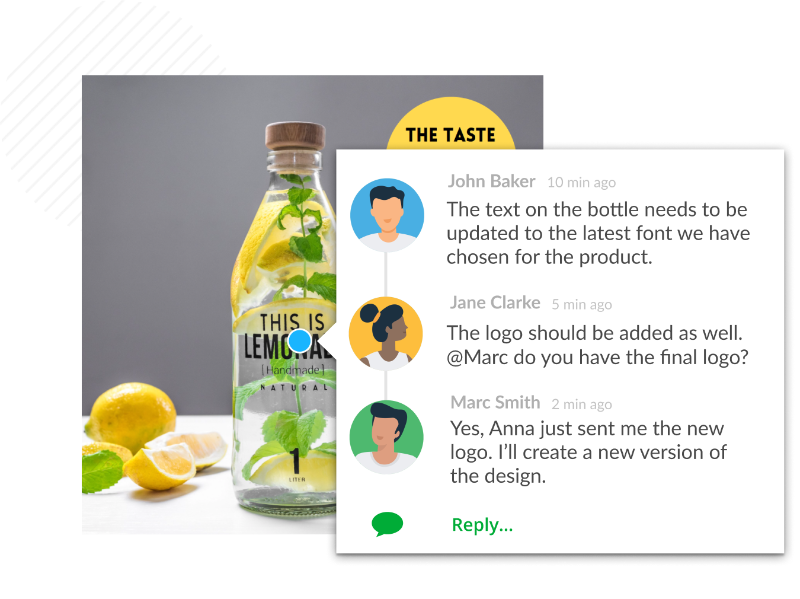
3 Tips for Agencies to Build a Highly Successful Relationship with Clients
If you’re working for a marketing agency instead, you need to build strong relationships with your clients for several reasons. For one, clients rely greatly on relationships before they make referrals, and they trust you with their brand’s image and reputation. To help you build a successful relationship with clients, the following three tips are essential.
Establish very close contact.
Do everything you can to make communication between you and clients frictionless. The better the communication, the stronger the relationship can become. It’s understandable, however, that you might not be able to keep up with all your clients at the same fast pace, especially if you have a growing volume of clients. To solve this problem, it’s always advisable to utilize agency software to keep client contact within arm’s reach.
Distancing yourself from clients can alienate them. And once clients begin to feel that gap, they will look to find an alternative solution or agency. Companies and agencies can close this gap easily by having a shared Slack channel, for example. This way, everyone can keep track of progress transparently as well as communicate through the channel.
Ask for feedback regularly.
You can’t deliver great quality outright. However, by asking for feedback, you can improve your service delivery.
When you request feedback from clients, they understand that their opinions are valued. Incorporating the feedback into changes accordingly shows clients that their input was truly considered. And, of course, clients want to stay in a relationship where they feel valued by people who are willing to grow.
There are several tools for requesting feedback on creative projects. Filestage is an excellent option for this use case for agencies as it allows users to grant review and commenting permission to external stakeholders, such as clients and third party collaborators.
Understand their brand and products properly.
By understanding a brand and their products in every detail, your agency becomes ingrained in a client’s business. You will be their go-to agency whenever they need help marketing their brand or any product. Why is that?
When you understand a client’s brand identity, it is simpler for your client to create briefings. Plus, the review and approval process will be faster since you already know what your client is expecting. This saves time and improves efficiency on both ends. And as you already know, clients prefer hassle-free collaborations. This strengthens your relationship and makes it more likely that this company will work with your agency for a very long time.
3 Key Factors for Developing the 3 Marketing Models (In-housing, Agency, and Hybrid)
Whether you are building an in-house marketing team, working with an agency or implementing a hybrid model, these three factors are important for the success of every model.
Set up clear processes.
Nothing is worse than busy people moving around in all directions. According to a study by M-Files, creative professionals spend 20-40% of their time locating documents manually and 50% of their time searching for information.
So, do your due diligence and set up a workflow structure that will guide how tasks are assigned, completed, delivered, reviewed, revised, and approved. A good workflow process should make it easy for your team to track the progress of files. This can save you a lot of time and increase productivity.
Define who should review and assign tasks. Also, the timeframe for completion should be considered when setting up your processes. More importantly, all processes should be clearly communicated or written down for everyone involved to easily access and understand.
Increase transparency.
A study published in Harvard Business Review revealed that employees are up to 20% more productive when transparency is highest.
Transparency within a team makes for more trust and better relationships between employees. With trust, employees can count on each other to play their part in the team’s progress.
To help increase transparency on your team, keep a main dashboard where collaborators can find all the relevant information about a project and see the progress of each task. The more information you share with your team, the higher the transparency. Plus, create a well-organized workflow that reveals the various processes involved in task completion. Regular meetings and group activities will also help employees connect better with each other.
For team leaders, giving employees avenues to express themselves can help build trust on a personal level. So, do well to listen to your employees when they express their ideas, difficulties, and concerns.
Direct communication
It is one thing to communicate, while it’s another to communicate directly and effectively. For each project, you need to set up a communication plan. With the right tool, direct and group messaging features can help you build clear communication with individuals or with all team members.
This direct communication is essential for guidance, sensitive corrections, and one-on-one communications that need to be shielded from public view.
Additionally, mentioning specific stakeholders in comments when collaborating can help feedback be communicated more directly. This way, every stakeholder is sure of who each comment and feedback is directed to, and overall clarity is enhanced.
A good tool for developing a reliable review and approval process for in-house teams, hybrid models or classic client-agency collaboration is Filestage.
Filestage allows teams to share, review and discuss files with internal colleagues as well as external partners or clients. The ability to comment on and annotate files makes it easy to leave clear feedback and discuss files with all reviewers in one centralized place. This makes collaboration and communication free-flowing.
Plus, Filestage’s dashboard gives collaborators an overview of the progress of each file in the workflow and a way to view the number of open comments as well as the submitted review decisions.
Conclusion
Marketing is a crucial part of any business. Focusing on it can be demanding, and businesses have outsourced this responsibility to agencies for years now. However, with the increasing dependency on data in recent times, most businesses are shifting to an in-house marketing or hybrid model.
Whether you choose to work with a marketing agency or to go with the more data-driven and secure in-housing option, a proper understanding of the pros and cons and efficient implementation is essential for your success.


